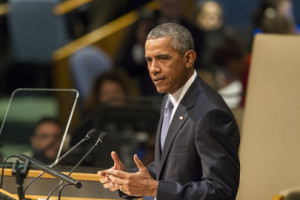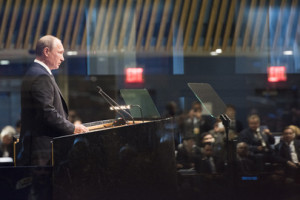The dangers from a new Cold War between the U.S. and Russia have prompted American peace activists to reach out to the Russian people and to fellow Americans to urge a step back from the cliff, as Kathy Kelly describes.
By Kathy Kelly
Since 1983, Sharon Tennison has worked to develop ordinary citizens’ capacities to avert international crises, focusing on relations between the U.S. and Russia. Now, amid a rising crisis in relations between the U.S. and Russia, she has organized a delegation which assembled in Moscow for a two-week visit. I joined the group on Thursday, and happened to finish reading Sharon Tennison’s book, The Power of Impossible Ideas, when I landed in Moscow.
An entry in her book, dated Nov. 9, 1989, describes the excitement over the Berlin Wall coming down and notes that “prior to the Wall’s removal” U.S. leaders “assured Secretary General Gorbachev that if he would support bringing down the Wall separating East and West Berlin, NATO would not move ‘a finger’s width’ closer to Russia than East Germany’s border. With this assurance Gorbachev gladly signed on.

President Barack Obama meets with President Vladimir Putin of Russia on the sidelines of the G20 Summit at Regnum Carya Resort in Antalya, Turkey, Sunday, Nov. 15, 2015. National Security Advisior Susan E. Rice listens at left. (Official White House Photo by Pete Souza)
“Little could he or the world have guessed that this promise would soon be broken … and that the redeveloping distrust between the countries would threaten to become a second Cold War, due to NATO’s expansion up to Russia’s borders.”
Today, NATO and U.S. troops will conclude 10 days of military exercises, Anaconda, on Russia’s western border, involving 31,000 troops. The operation was named after a snake that kills by crushing its prey. Ongoing deployment of 4,000 additional NATO troops has been announced. U.S. and South Korean military exercises just completed at the Demilitarized Zone between North and South Korea were dubbed “Decapitation” and mobilized 320,000 troops.
Conn Hallinan, in “Bear Baiting Russia,” notes that “Russia has two bases in the Middle East and a handful in Central Asia. The U.S. has 662 bases in foreign countries around the world and Special Forces (SOF) deployed in between 70 and 90 countries at any moment. Last year SOFs were active in 147 countries. The U.S. is actively engaged in five wars and is considering a sixth in Libya. Russian military spending will fall next year, and the U.S. will out-spend Moscow by a factor of 10. Who in this comparison looks threatening?”
Mutual Learning
It’s important for U.S. people to learn more, from ordinary Russian people, about their responses to troop build-ups and new bases on their borders, threatening military exercises, and antagonistic arsenals of nuclear weapons on high alert. As President Vladimir Putin begins summoning a new Russian National Guard that could include 400,000 troops, it’s important to hear how Russian people feel about this development.
Rather than foster cartoonized versions of foreign policy, the U.S. media should help people recognize complexity in Russian society and include awareness of desires to live in peace on the part of people in both countries.
U.S. people committed to peace-making might help ordinary Russians sense the complexity of U.S. society and better understand how U.S. military spending and build-up toward war adversely affects civil society in the U.S.
Suppose someone in Russia were to ask me what I was doing before coming to Russia. In honesty, I’d explain that in the previous week, companions and I finished a 150-mile walk to a Supermax prison in my home state of Illinois which could eventually subject 1,900 people to tortuous years of solitary confinement, doubling the number of such cells in the U.S. Like the military-industrial complex in the U.S., the prison-industrial complex is now rooted in government salaries and corporate profits, and it’s hard to uproot it.
Before joining the walk, I lived for several weeks in late May and early June with young volunteers in Kabul who long to “live without war.” Fifteen years into the U.S. war in Afghanistan, the U.S. has “succeeded” in creating conditions for ongoing war.
NATO and U.S. officials claim that their military exercises in countries around the world will enhance international security, but those of us who are members of the delegation here in Russia believe that it’s essential to swiftly reverse the present trend toward Cold Wars with Russia and China.
Delusions of Domination
The fantasy of world domination endangers people throughout the world and within the U.S. as people again shudder over the possibility of war between nuclear-armed powers.

U.S. President Barack Obama addresses the United Nations General Assembly on Sept. 28, 2015. (Photo credit: United Nations.)
Dmitri Babich, an active journalist for over 25 years focusing on Russian politics, said it’s important to name the problem we face, and he believes the fundamental problem is the U.S. insistence on being institutional supremacists, – exceptionalists.
In other words, the policy fantasy that stands in the way of addressing major world problems cooperatively is the idea that the United States can retain and expand the boundaries of “sole superpower” domination. United States policy should stop poking and provoking Russia and China along their frontiers, and instead seek negotiated peaceful coexistence.
Missiles fitted with thermonuclear warheads and on battle-ready status are unstable, and, at any time, can result in the catastrophic destruction of cities on both sides, and even the ending of civilized life on earth.
With active cooperation among the great powers and large reductions in wasteful competitive military spending, all countries could cooperatively address the threats from climate change, water shortages, regional underdevelopment, and economic pressures caused by population growth.
Ordinary people everywhere should do all that we can to demand that all international disputes be resolved by non-military means, avoiding all wars and achieving the deactivation of all nuclear weapons.
Sharon Tennison’s work to develop citizen-to-citizen diplomacy, since 1983, suggests that people could work together to tackle such problems. But, informed public opinion in the U.S. and in Russia will be crucially needed.
My friend Brad Lyttle, a lead organizer of and participant in the “San Francisco to Moscow Walk” (1960 -1961) recently wrote to President Obama that there is no reason why the U.S. and Russia should continue to jeopardize the very existence of the human species with their huge nuclear arsenals.
“Work with President Putin to reduce and eliminate these,” wrote Lyttle. “Emphasize a trustful and positive approach. Don’t assume that the future needs always to be as bad as much of the past.”
Kathy Kelly (Kathy@vcnv.org)co-coordinates Voices for Creative Nonviolence www.vcnv.org


I appreciate all peacemakers efforts. US Forign Policy has been wrong for many years; destructive and aggressive.
I find this trip of peacemakers to Russia to be tremendously hopeful. I lived in Nicaragua (1986-88) during the Contra War there, when delegations from Witness for Peace were traveling back and forth to Nicaragua. They would return to the States and speak in churches, to journalists, in Congressional offices, etc., about what they had seen and heard of the war, and began to erase the lies that were being told in the States.
And today, in the context of nuclear threat, with NATO’s presence on Russia’s Western border, I think of Fr. Thomas Merton’s advice to Christians, and really to all of us, “not to contribute to the blind forces of annihilation, but to orient one’s efforts towards world unity and not towards world division.” The efforts of this peacemakers delegation may be a part of the kind of revolution that we eagerly seek.
Note to Kathy Kelly – the Powers That Be could have done these things a long time ago – especially when the USSR disintegrated. They didn’t want to do them so the things you speak of didn’t happen.
I see no reason to suppose anything is going to change now – except for the worse. All those “huge nuclear arsenals” you mentioned aren’t really very much danger if they’re in highly secure places in the charge of peace-loving and honest and sane people. It’s when the warmongering & dishonest & unstable folks get control of them that they really become a problem.
Consider one of the many stunts being pulled by our Nobel Peace Prize laureate. He is moving a dual-purpose weapons system to the very borders of Russia. Officially it’s a defense-of-Europe-against-evil-Iranians, but the actual purpose is to threaten Russia. Not being fools, the Russians know this, and see it as a threat to their very existence.
Yes, the “defensive” missiles – a silly pretense if there ever was one – can be instantly replaced by the new Tomahawk Block IV cruise missiles being developed. As Putin says, they’ll have a range of at least 1000 miles, and possibly considerably more. Read what he says – and think about the ‘between-the-line’ things he hints at and doesn’t say. In my opinion when Russian Intelligence learns the new Tomahawks are in production, something very destructive is going to happen to those new missile sites on their borders.
https://www.rt.com/news/347313-putin-us-missile-defense-nuclear/
At that time Russia will be fully prepared for any level of war NATO desires.
Still an opinion, but I’d expect the Aegis Ashore complexes will be taken out with conventional weapons. Just as an example, here is a video of a recent Russian attack on an ISIS arms depot.
hXXp://www.fort-russ.com/2016/06/rain-of-fire-russian-airforce-strikes.html
I’ve no idea what kind of ordnance caused that “rain of fire”, but imagine ten-twenty times that number with Aegis Ashore sites the targets.
I’ve read internet stories claiming the Russians are already training for the specific task of destroying the missile sites. If that’s not true now, I expect it will be rather soon.
I applaud the delegation’s efforts. People can always make a difference, and I believe oftentimes we don’t realize how meaningful the differences we make in the lives of others are.
But it will be quite a stretch when the U.S. MSM ever helps people realize the complexity of anything, let alone of Russian society. Informed public opinion is crucial, but just as important is a proper public ethos. We got a lot of work to do on both counts.
Ms. Kelly may have forgotten to mention that Ann Wright and Ray McGovern of VIPS are also in the delegation, which Wright wrote about here just a few days ago:
https://consortiumnews.com/2016/06/15/bridging-divides-of-a-new-cold-war/
It is so wonderful to see these people practice diplomacy at a time when America’s only policy seems to be War. Remember that it was “back door” negotiations that saved us from the last nuclear confrontation…
Bob Van Noy… Meanwhile we are just reading about 51 State Department Diplomats signed a memo for military strikes against Assad which would put the US head-to-head with the Russian military. So it is great to have people go from the US to show solidarity, it proves to almost be a double edged sword when at the same time the US is pushing for such “aggression” in Syria and I believe that if Clinton is elected then this could very well come to fruition. Of course, if it happens, it will be all Russia and Assad’s fault… wink, wink, nudge, nudge.
I’m sorry to be cynical but these efforts are doomed and it is not because these people are wrong. It is just because the current atmosphere has been poisoned by the past. These people will be dismissed as ‘useful idiots’ and the ‘blame America first’ crowd.
The only thing that might change the situation is a positive outcome in Syria where Assad’s forces play a prominent role in defeating ISIS and Syria becomes a stable country. However, even if that happens it looks like our glorious western MSM is managing those expectations so that even that probably will not make a difference.